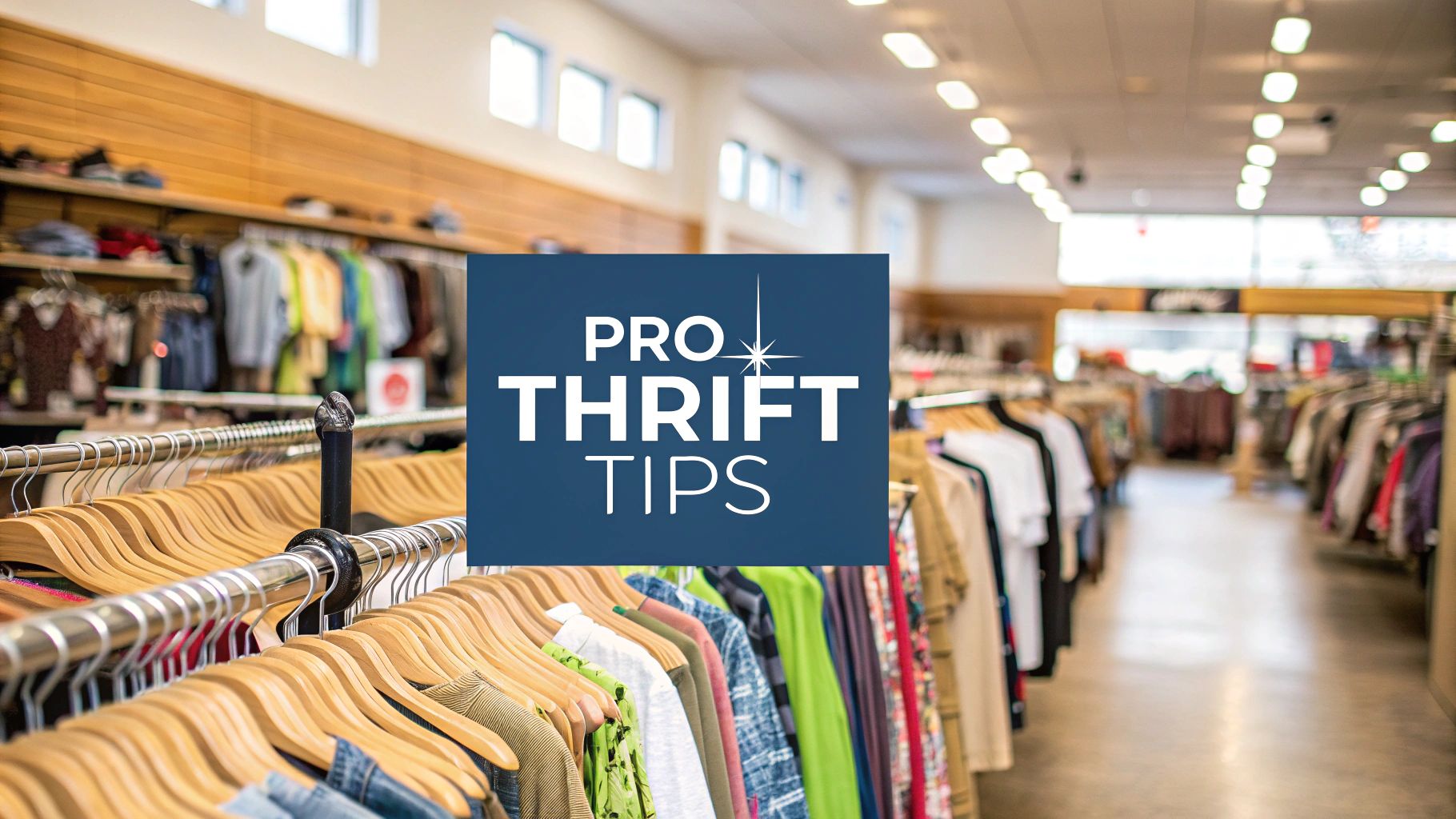Thrift store shopping is more than just a way to save money; it's a treasure hunt, a sustainable choice, and a path to discovering unique items with a soul. But navigating the endless racks of pre-loved goods can be overwhelming. Without a strategy, you might miss out on incredible finds or go home with items you don't truly need. This guide offers a curated collection of actionable thrift store shopping tips designed to transform your experience from a chaotic browse into a targeted, successful mission.
We'll move beyond the obvious advice and provide specific, practical strategies to help you spot hidden gems, assess value like a pro, and make every trip to the thrift store a rewarding adventure. You will learn precisely how to prepare for your shopping trips, what to look for on the racks, and how to understand the inner workings of your favorite stores. The goal is to build a repeatable process that maximizes your chances of success.
From researching valuable brands before you go to knowing the best times to shop, these insights are built for implementation. Whether you're a seasoned reseller hunting for inventory, a vintage enthusiast curating a unique wardrobe, or a beginner looking to furnish a home on a budget, these tips will equip you to uncover the true potential hiding on every shelf.
1. Master the Clock: Why Timing is Everything in Thrifting
One of the most effective thrift store shopping tips is understanding that when you shop is just as important as where you shop. The best items, from designer clothing to unique home decor, are often snatched up within hours of hitting the sales floor. Arriving shortly after a store restocks its shelves gives you the first pick of new inventory before it gets buried or bought by other shoppers.
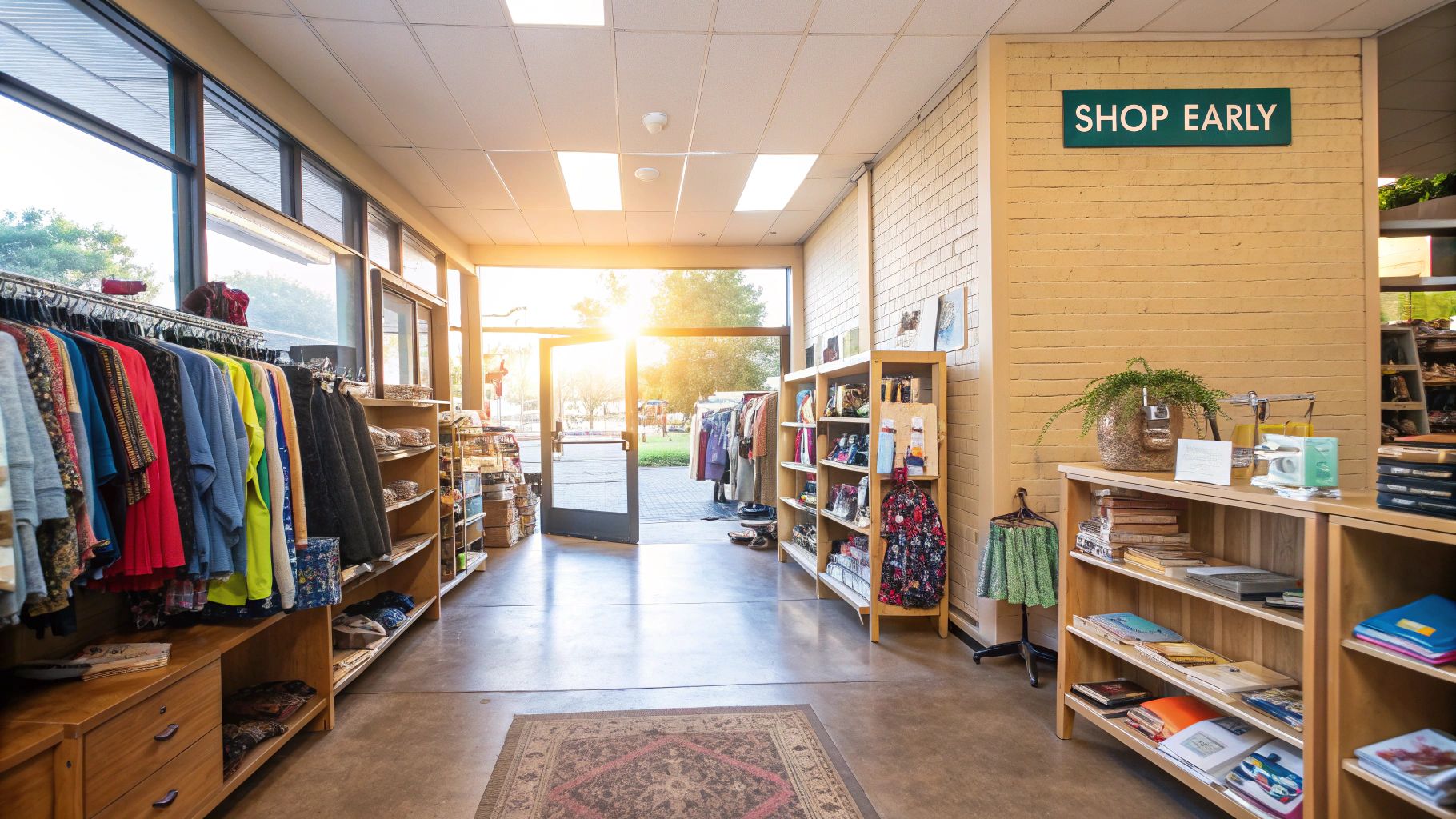
Most thrift stores receive donations daily but have specific schedules for sorting and stocking. Learning this internal rhythm is your secret weapon. This isn't just about showing up early; it's about showing up at the right time.
How to Decode Your Store's Schedule
Every store operates differently, so a little reconnaissance work is required. Major chains and small local shops have unique patterns you can learn.
- Goodwill & Salvation Army: These larger stores often process donations over the weekend, making Monday and Tuesday mornings prime time for new arrivals. For example, estate sale drop-offs frequently happen over the weekend, and those items get priced and placed on the floor early in the week.
- Local & Church Thrifts: Smaller, volunteer-run shops may have more distinct schedules. A church thrift store might restock right after weekend services, making Sunday afternoon or Monday morning the ideal time to visit.
Pro Tip: Shopping mid-week, especially on a Tuesday or Wednesday, often yields the best results. The weekend rush is over, and the shelves have been replenished with fresh donations that haven't been picked over yet.
Actionable Steps for Perfect Timing
- Ask an Employee: The most direct approach is often the best. Politely ask a staff member, “What day is best for finding new furniture?” or “When do you usually put out new clothing?” They can give you insider information.
- Become a Regular: Visit your favorite stores once or twice a week at different times. You’ll quickly notice patterns, like seeing new items on a Wednesday morning or watching staff roll out new racks on a Friday afternoon.
- Follow on Social Media: Many thrift stores now use Facebook or Instagram to announce big donation drops, special sale days, or even showcase newly stocked high-value items. This gives you a digital heads-up.
2. Know Your Measurements and Sizes
Relying on the size tag is one of the biggest mistakes you can make while thrift shopping. Clothing sizes vary dramatically between brands, decades, and countries, making a "medium" from one brand fit like a "large" from another. Since many thrift stores have limited fitting rooms or strict "no return" policies, knowing your exact measurements is an essential thrift store shopping tip to avoid disappointment.
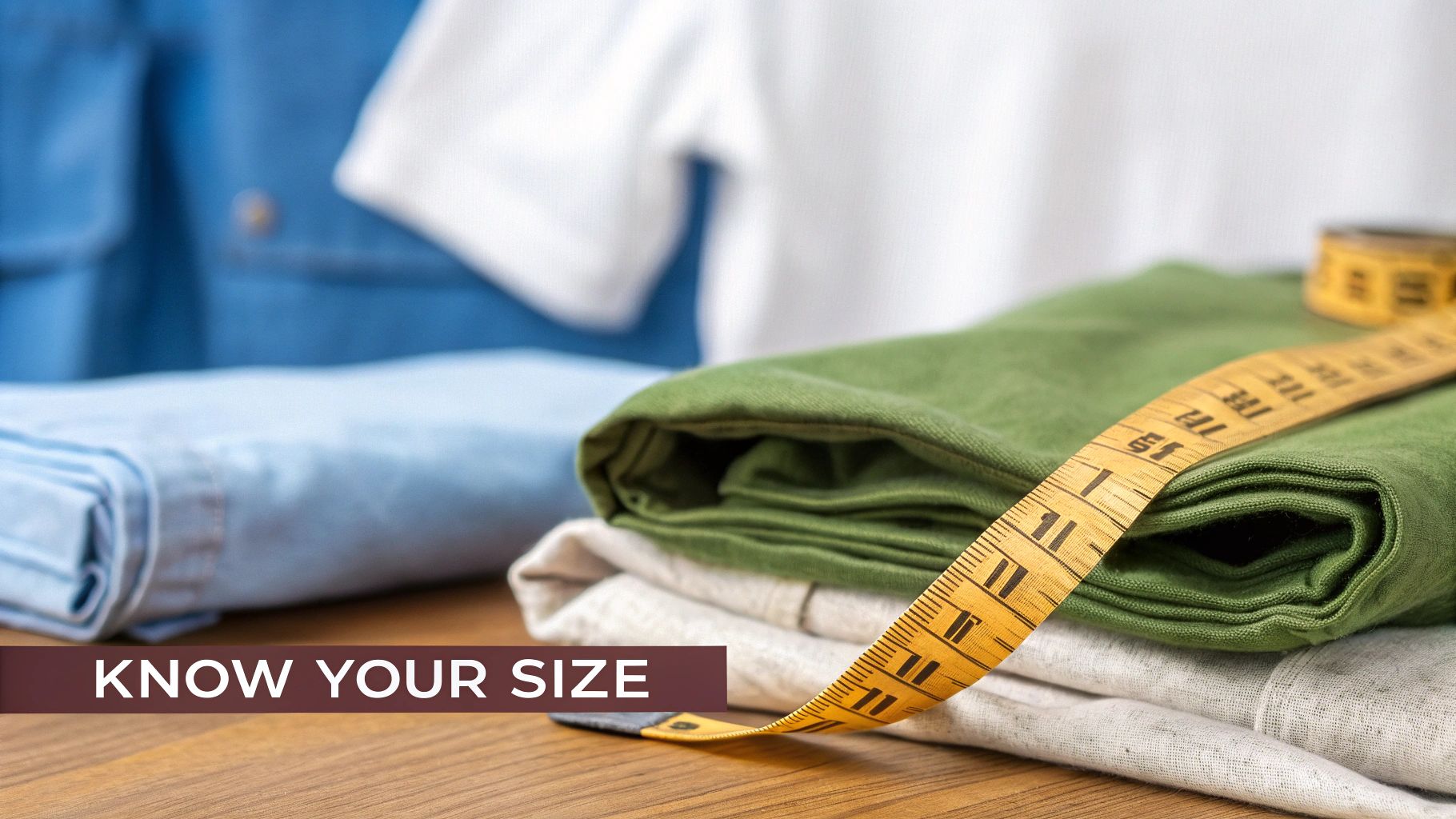
Vintage and international sizing can be especially tricky. A dress from the 1960s labeled a size 12 might be closer to a modern size 6 or 8. Similarly, a European size 40 jacket is not the same as a US size 40; it's a US size 10. Being armed with your measurements allows you to instantly know if a piece has potential, regardless of what the tag says.
How to Measure for Success
Memorizing a few key numbers will transform your ability to spot items that will fit you perfectly, saving you time and money.
- Key Measurements: Before you go shopping, measure your bust, waist, hips, and inseam. For tops and jackets, knowing your shoulder-to-shoulder and arm length is also helpful. Keep these numbers saved in a note on your phone.
- Vintage vs. Modern: Be aware that vintage sizing was often based on different body proportions. For example, vintage Levi's jeans were measured based on their pre-shrunk size, unlike modern pairs that account for shrinkage.
Pro Tip: Measure a few of your favorite, best-fitting garments at home (e.g., the waist of your favorite jeans, the bust of your go-to blouse). You can then compare these measurements directly to items in the store, which is often faster than measuring your own body.
Actionable Steps for a Perfect Fit
- Always Carry a Tape Measure: A small, retractable sewing tape measure is a thrifter’s best friend. It takes up no space in your bag and allows you to measure a garment in seconds. Some smartphone apps also offer measurement tools.
- Learn to Eyeball It: With practice, you can learn to visually estimate if a garment will fit. Hold a pair of pants up to your waist or wrap the waistband around your neck; for many people, if the ends meet, the pants will fit.
- Factor in Alterations: Don’t pass up a high-quality wool coat or a silk dress just because it’s slightly too big. If you find a designer piece for a steal, a simple alteration can still be far cheaper than buying it new.
3. Inspect Items Thoroughly Before Buying
One of the most critical thrift store shopping tips is to remember that nearly every item is sold "as-is." This means no returns or exchanges, so what you see is what you get. A thorough inspection is your only defense against buyer's remorse, preventing you from bringing home an item with hidden flaws that make it unusable or decrease its value.
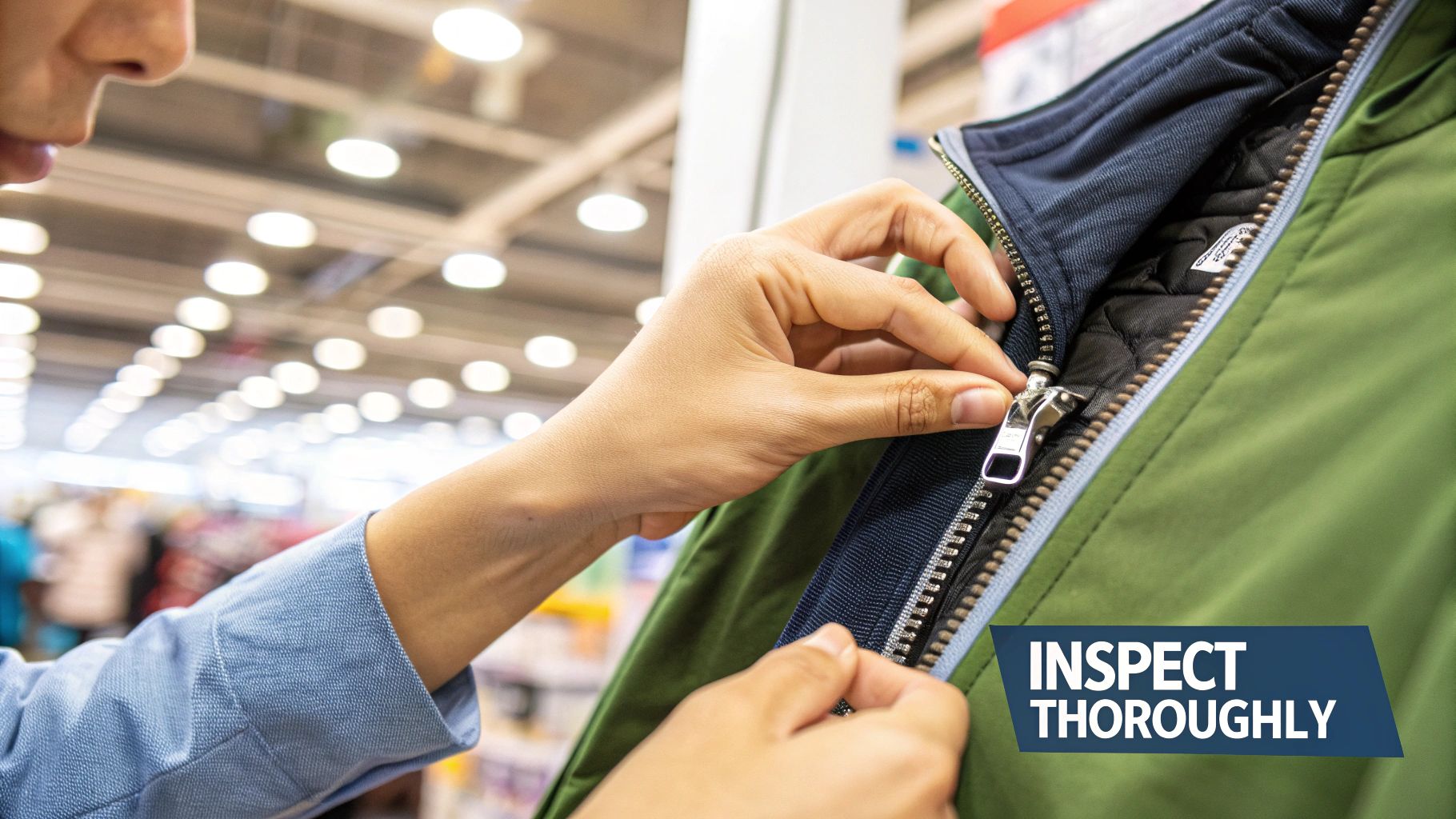
This process is about more than just a quick glance. It’s about looking past the surface to identify potential issues like damage, missing parts, or functionality problems. At the same time, it helps you spot diamonds in the rough, like a vintage leather jacket with a broken zipper that’s easily repairable, making a $200 item a steal at $15.
What to Look For: A Room-by-Room Guide
Your inspection method should adapt to the item you're considering. From clothing to electronics, each category has unique weak points that require a focused check.
- Clothing & Textiles: Check all zippers, buttons, and snaps. Hold garments up to the light to spot small holes or thinning fabric. Look for stains in high-traffic areas like armpits, collars, and cuffs. Sniff for persistent odors like smoke or mothballs that may not wash out.
- Furniture: Test for stability. Wiggle chairs and tables to check for loose joints. A minor wobble can often be fixed with wood glue, but major structural damage is a red flag. Open all drawers and doors to ensure they function smoothly.
- Electronics: If possible, find an outlet in the store to test items. For battery-operated devices, open the battery compartment to check for corrosion. Look for frayed cords or missing essential accessories.
Pro Tip: Use your phone's flashlight to get a better look inside dark items, under furniture, or at the seams of clothing. It's a simple tool that can reveal flaws the store's overhead lighting might miss.
Actionable Steps for a Flawless Inspection
- Create a Mental Checklist: Before you enter the store, have a mental list of what to check for based on what you’re hunting for. For jeans, it might be the zipper, belt loops, and crotch seam. For a blender, it’s the blade, base, and cord.
- Use the Fitting Room: Always try on clothing. Sizing can be inconsistent, and trying items on is the only way to check for fit and find hidden tears or stains you might have missed on the rack.
- Assess the "Fixability": When you find a flaw, ask yourself, "Is this something I can realistically fix?" A missing button is an easy repair, but a large, permanent stain on a designer handbag might not be. Be honest about your skills, time, and resources.
4. Research Valuable Brands and Items
One of the most powerful thrift store shopping tips is to arm yourself with knowledge. While thrift store employees do their best, they can't be experts on everything. This knowledge gap is where you can find incredible deals, as valuable brands, vintage items, and collectibles are often priced far below their market value.
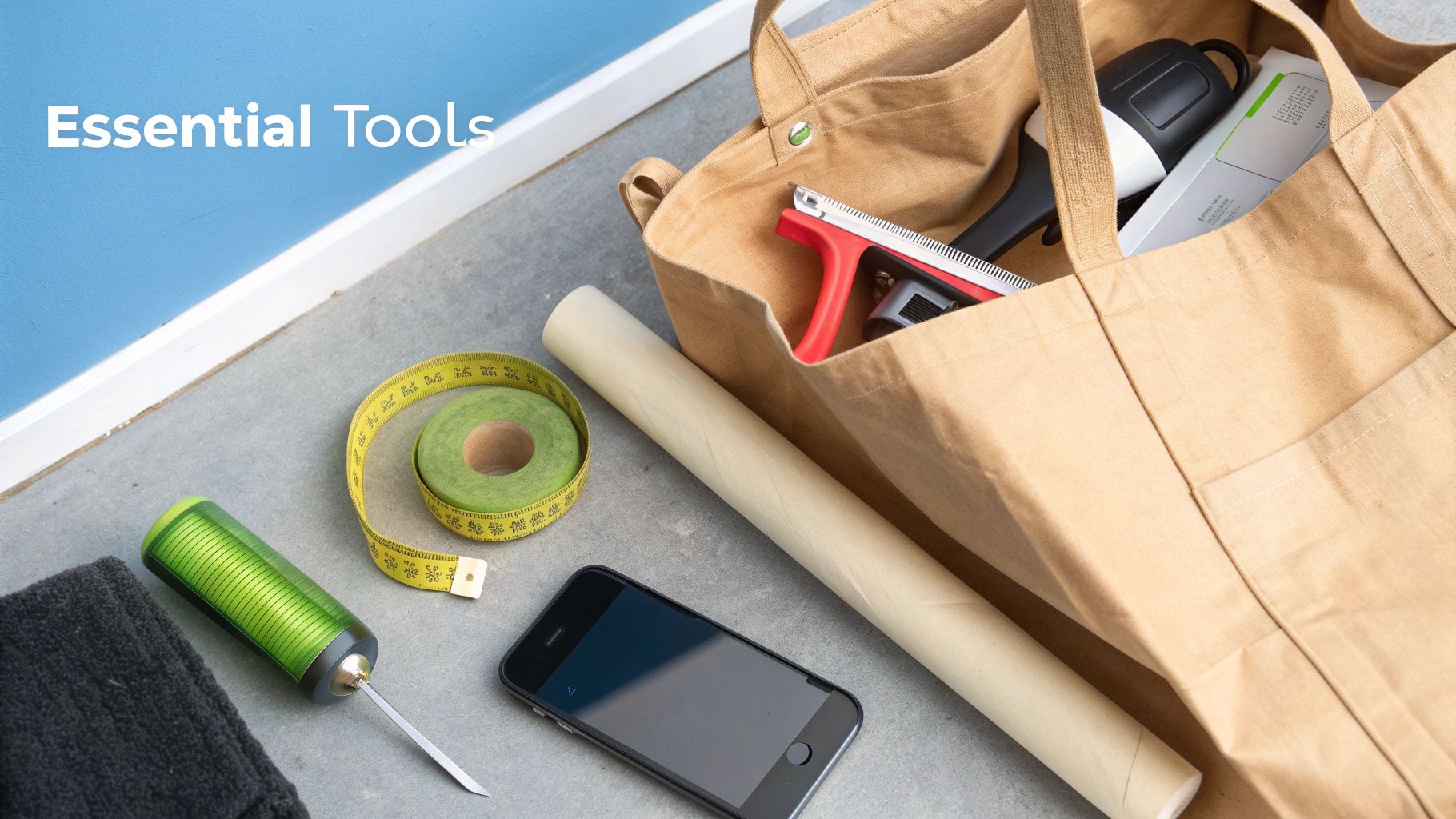
From designer handbags to rare first-edition books, treasures are waiting for the informed shopper. For example, a vintage Pyrex bowl with a specific pattern might be priced at $3 but sell to collectors for over $100. Similarly, a mid-century modern armchair could be mistaken for generic old furniture but be worth thousands.
How to Build Your Thrifting Expertise
Developing an eye for value takes practice, but you don't need to be an expert in everything. Focusing on a few categories you're passionate about is the key to success.
- Designer Fashion: Learn the tell-tale signs of a high-quality handbag or coat, such as stitching, hardware, and specific logo details. A Coach or Dooney & Bourke bag worth $500+ can easily be found for under $20.
- Vintage Housewares: Certain vintage Pyrex or CorningWare patterns are highly sought after by collectors. A quick search on your phone can reveal if that floral casserole dish is a common find or a rare gem.
- Furniture & Decor: Familiarize yourself with the markers of different design eras, like the clean lines of mid-century modern or the ornate details of Victorian furniture. Look for manufacturer stamps or labels on the underside of pieces.
Pro Tip: Use your smartphone as your personal appraiser. Apps like eBay and Google Lens let you quickly check the "sold" listings for an item to see its real-world market value before you buy.
Actionable Steps for Spotting Hidden Gems
- Focus Your Knowledge: Start by mastering one or two categories, such as vintage vinyl records, first-edition books, or a specific clothing brand. This makes the learning process manageable.
- Learn Authentication Markers: For luxury goods, study the details that separate real from fake. This includes logo placement, zipper types, and material quality. It is also helpful to learn more about how to spot fake antiques to avoid costly mistakes.
- Follow Collector Communities: Join online forums, subreddits, or Facebook groups dedicated to your chosen niche. These communities are a goldmine of information on identifying valuable items and understanding current market prices.
5. Shop with a List but Stay Open to Discoveries
One of the most effective thrift store shopping tips is to strike a balance between focused hunting and spontaneous discovery. Walking in with a clear list prevents you from making aimless, impulsive purchases and ensures you search for items you genuinely need. However, the true magic of thrifting lies in the unexpected treasures you find along the way.
This dual approach keeps your shopping trip productive without sacrificing the thrill of the hunt. You might be looking for a basic winter coat but stumble upon a vintage leather jacket in your exact size, or search for simple dinner plates and find a complete, matching set of mid-century modern dishware. The list provides direction, while flexibility allows you to capitalize on rare opportunities.
How to Blend Planning with Flexibility
Successfully navigating a thrift store means knowing what you’re looking for while keeping your eyes peeled for hidden gems. This strategy helps you build a curated home and wardrobe with purpose.
- Define Your Needs: Before you go, jot down specific items. Are you looking for a sturdy bookshelf for your office? Or maybe a pair of basic jeans? This initial focus prevents you from getting overwhelmed by the sheer volume of inventory.
- Embrace the Unexpected: The best finds are often things you never knew you needed. That bookshelf hunt might lead you to a unique vintage barrister bookcase that offers far more character and storage than a modern alternative.
Pro Tip: Keep photos of your rooms or closet on your phone. When you find a potential item, you can quickly reference your space to see if the color, style, and size will work, preventing buyer's remorse.
Actionable Steps for a Balanced Shopping Trip
- Prioritize Your List: Divide your list into two columns: 'Needs' and 'Wants.' Focus on finding your 'needs' first, but allow yourself to browse for 'wants' if you find a great deal. This structure helps you stay on track and on budget.
- Set a "Discovery Budget": Allocate a small portion of your spending money, perhaps 20%, for unexpected finds. This gives you the freedom to purchase a great item not on your list without feeling guilty.
- Review Your List Mid-Shop: Periodically check your list while you shop. If you find a fantastic substitute for an item you were looking for, you can cross it off and refocus your search. Recognizing the best things to buy at thrift stores can help you spot high-value opportunities.
6. Understand Store Pricing and Sale Patterns
Beyond finding the perfect item, one of the most satisfying parts of thrifting is getting an incredible deal. A core thrift store shopping tip is to move beyond the sticker price and learn the internal systems that dictate sales and discounts. Each store has its own rhythm for marking down items, offering you a second chance to save big if you know how to play the game.
Understanding a store's pricing strategy and sale schedule unlocks a new level of savvy shopping. It allows you to strategically plan your visits and decide whether to buy an item now or wait for a potential markdown. This knowledge separates the casual browser from the master thrifter who consistently scores the best bargains.
How to Decode Your Store's Discount System
Every store, from national chains to small-town charity shops, has a method for managing inventory and encouraging sales. Learning these unique patterns can lead to significant savings.
- Goodwill: Many Goodwill regions use a colored tag system. Each week, a specific color is designated for 50% off. If you find an item with that week’s colored tag, your price is instantly cut in half. The rotation schedule is usually posted near the entrance or checkout counter.
- Salvation Army: These stores are famous for their Family Day sales, often held mid-week (like Wednesdays), where all clothing or a specific category might be 50% off. Some locations also have designated "$1 clothing days" or other deep discounts on specific weekdays.
- Local & Independent Thrifts: Smaller shops often have unique promotions. You might find a student discount day, a senior discount on Tuesdays, or even "bag sales" where you can fill a provided bag for a flat rate, like $10.
Pro Tip: Don't be shy about asking if a slightly damaged item qualifies for a discount. A missing button on a jacket or a small chip on a vase could earn you an extra 10-20% off if you politely point it out to a manager.
Actionable Steps for Maximizing Savings
- Look for the Signs: Upon entering any thrift store, scan the walls near the entrance and the registers. This is where most stores post their sale schedules, colored tag of the week, and daily specials.
- Sign Up for Alerts: Many thrift chains now have loyalty programs, email newsletters, or text alert systems. Signing up is the fastest way to get notified about upcoming 50% off days or special promotional events.
- Learn the Color Rotation: If your favorite store uses a colored tag system, start tracking the rotation. You'll quickly learn the sequence (e.g., blue, then green, then yellow) and can predict which color will be on sale next, helping you decide whether to buy an item immediately or wait.
7. Bring Essential Shopping Tools
A successful thrift store trip often depends on more than just good luck; it requires good preparation. Walking in with a few essential tools can transform your shopping from a hopeful hunt into a strategic mission. Having the right items on hand helps you evaluate potential treasures accurately, make confident decisions, and handle your finds with care.
This preparation is a key difference between amateur and seasoned shoppers. It allows you to verify an item's fit, condition, and value on the spot, ensuring you don’t pass on a hidden gem or go home with something that doesn’t work for your space.
How to Build Your Thrifting Toolkit
Your toolkit doesn’t need to be bulky. A small bag or a dedicated section of your purse can hold everything you need to become a more efficient and effective shopper.
- Furniture & Decor: A tape measure is non-negotiable. Use it to confirm that a beautiful side table will actually fit in your entryway or that a picture frame is the right size for your print.
- Clothing & Textiles: A lint roller can instantly reveal the true condition of a fabric under a layer of dust or fuzz. This helps you better assess quality and spot hidden stains or damage.
- Collectibles & Electronics: Your smartphone is your research hub. Use it to look up brand names, check the value of a vintage book, or see if a particular electronic device has good reviews.
Pro Tip: Keep a charged power bank in your car. There’s nothing worse than finding a potential designer bag and having your phone die before you can research its authenticity markings.
Actionable Steps for a Prepared Shopping Trip
- Create a Go-Bag: Designate a small tote or pouch specifically for your thrifting tools. Keep it stocked with a tape measure, lint roller, hand sanitizer, and a small notebook and pen.
- Download Useful Apps: Before you go, download a barcode scanner app or an app like Google Lens. These tools can help you quickly identify items and look up their market value online.
- Carry Cash: While most stores accept cards, having small bills makes transactions smoother, especially at smaller charity shops or during busy yard sale-style events. Many of the same preparation principles apply to other secondhand markets; you can get more tips on how to prepare for a successful hunt by exploring these estate sale buyer strategies on curio.app.
8. Build Relationships with Store Staff
One of the most overlooked yet powerful thrift store shopping tips is to connect with the people who work there. Building a friendly rapport with staff can transform you from just another shopper into a valued regular, giving you access to insider knowledge that others miss. They see every item that comes in and can become your greatest ally in the hunt for hidden treasures.
Employees are the gatekeepers of the store's inventory flow. A friendly face and genuine conversation can lead to valuable tips about when specific donations are processed, what unique items have just arrived, or when the next big sale is scheduled. This human connection adds a rewarding layer to the thrifting experience.
How to Become a Valued Regular
Creating a positive relationship is about being consistently kind, respectful, and genuinely interested. It’s not about being demanding; it’s about making a memorable, positive impression.
- Estate Sale Intel: A manager who knows you collect vintage Pyrex might mention that a large estate donation full of kitchenware just arrived and will be priced by tomorrow morning.
- Item Alerts: An employee who remembers you’re looking for a mid-century modern armchair might give you a heads-up if they see one in the backroom, allowing you to be the first to check it out once it hits the floor.
Pro Tip: Sharing your specific interests can pay off significantly. If you collect something specific like vinyl records or vintage board games, mention it casually. Staff members are more likely to remember and point things out if they know what you're looking for.
Actionable Steps for Building Rapport
- Be Genuinely Friendly: A simple “Hello, how’s your day going?” can go a long way. Learn a few names and use them. A little kindness makes you stand out from the transactional rush of daily shoppers.
- Ask for Their Expertise: Instead of just asking what’s new, ask for their opinion. For example, "You see so much come through here. Have you noticed any interesting furniture brands lately?" This shows you value their knowledge.
- Share Your Finds (and Passion): When you check out, briefly share your excitement about a great find. Saying, "I've been searching for a piece like this for months!" helps them connect with your passion and remember your interests for the future.
- Respect Their Time: Be mindful that employees are busy. Keep conversations brief, especially during peak hours. Never ask them to break store rules, such as setting items aside for you unofficially.
Thrift Store Shopping Tips Comparison
| Strategy | Implementation Complexity 🔄 | Resource Requirements ⚡ | Expected Outcomes 📊 | Ideal Use Cases 💡 | Key Advantages ⭐ |
|---|---|---|---|---|---|
| Shop Early and Often | Medium - requires flexible schedule 🔄 | Time investment for frequent visits ⚡ | Better item availability and quality 📊 | Serious thrifters seeking rare finds 💡 | First access, less competition ⭐ |
| Know Your Measurements and Sizes | Medium - requires prep & tools 🔄 | Tape measure, apps, research ⚡ | Reduced purchase errors and returns 📊 | Buying vintage/international clothes 💡 | Confident fit, time-saving ⭐ |
| Inspect Items Thoroughly Before Buying | High - time-consuming inspection 🔄 | Knowledge of defects, patience ⚡ | Avoids bad purchases and repairs 📊 | Items with complex condition (clothing, electronics) 💡 | Prevents buyer's remorse, price negotiation ⭐ |
| Research Valuable Brands and Items | High - requires extensive learning 🔄 | Research tools, apps, communities ⚡ | Finds underpriced valuable items 📊 | Resellers, collectors, bargain hunters 💡 | Potential profit, expertise ⭐ |
| Shop with a List but Stay Open to Discoveries | Low - planning and flexibility 🔄 | List creation, budgeting ⚡ | Controlled spending with serendipity 📊 | Balanced shopping for needs and wants 💡 | Reduces waste, maximizes value ⭐ |
| Understand Store Pricing and Sale Patterns | Medium - tracking sales and discounts 🔄 | Following store programs and schedules ⚡ | Significant cost savings 📊 | Budget-conscious shoppers 💡 | Predictable deals, loyalty benefits ⭐ |
| Bring Essential Shopping Tools | Low - preparing items before trips 🔄 | Tape measure, smartphone, bags ⚡ | More efficient and informed shopping 📊 | General thrift shopping 💡 | Better decisions, professionalism ⭐ |
| Build Relationships with Store Staff | Medium - time & social effort 🔄 | Time investment, interpersonal skills ⚡ | Insider info and early access 📊 | Regular shoppers wanting inside tips 💡 | Access to special info, improved service ⭐ |
Unlocking Value in Every Aisle
Stepping into a thrift store is like opening a book to a random page; you never know what story you’ll find. But with the right approach, you can go from being a casual reader to a skilled archivist, capable of identifying and preserving treasures others overlook. The journey from a novice thrifter to a seasoned expert isn't about luck, it’s about strategy. The thrift store shopping tips we've explored are the building blocks of that strategy, transforming your routine visits into calculated, rewarding expeditions.
From Casual Shopper to Strategic Hunter
Mastering the art of thrifting means shifting your mindset. You're no longer just looking for a cheap shirt or a functional coffee mug. You're searching for value, history, and potential. This guide has equipped you with a complete toolkit to make that shift happen.
- Consistency and Timing: Remember that shopping early and often is your greatest advantage. The constant flow of new donations means the landscape changes daily, and being the first to see fresh inventory gives you an unmatched edge.
- Preparation is Power: Walking in prepared with your measurements, a detailed list, and your essential shopping tools (like a tape measure and magnet) immediately sets you apart. This preparation eliminates guesswork and allows you to make confident, quick decisions when you spot a potential gem.
- Knowledge is Currency: The difference between a $5 dusty relic and a $500 hidden treasure is knowledge. Diligently researching brands, understanding store sale patterns, and knowing how to thoroughly inspect an item for flaws or authenticity are non-negotiable skills. This is where your true power as a thrifter lies.
The Art of the Find
Ultimately, these thrift store shopping tips are about more than just saving money. They are about curating a life filled with unique, meaningful objects that have a story. It’s about the thrill of discovering a vintage, handcrafted piece of furniture, the satisfaction of finding a rare first-edition book, or the joy of giving a beautiful, pre-loved item a second life. Each successful find reinforces your skills and fuels your passion for the hunt.
By building relationships with staff, you gain allies who can point you toward new arrivals. By balancing your shopping list with an open mind, you leave room for the serendipitous discoveries that make thrifting so magical. You now have the framework to approach every aisle with purpose and every item with a discerning eye. The next time you push a cart through those automatic doors, you won't just see racks of old clothes; you'll see a world of hidden potential, waiting for you to unlock it. Happy hunting!
Ready to take your item identification skills to the next level? The Curio app uses advanced image recognition to help you instantly identify antiques, collectibles, and valuable brands right from your phone. Stop guessing and start knowing what your thrift store finds are worth by visiting Curio to learn more.
